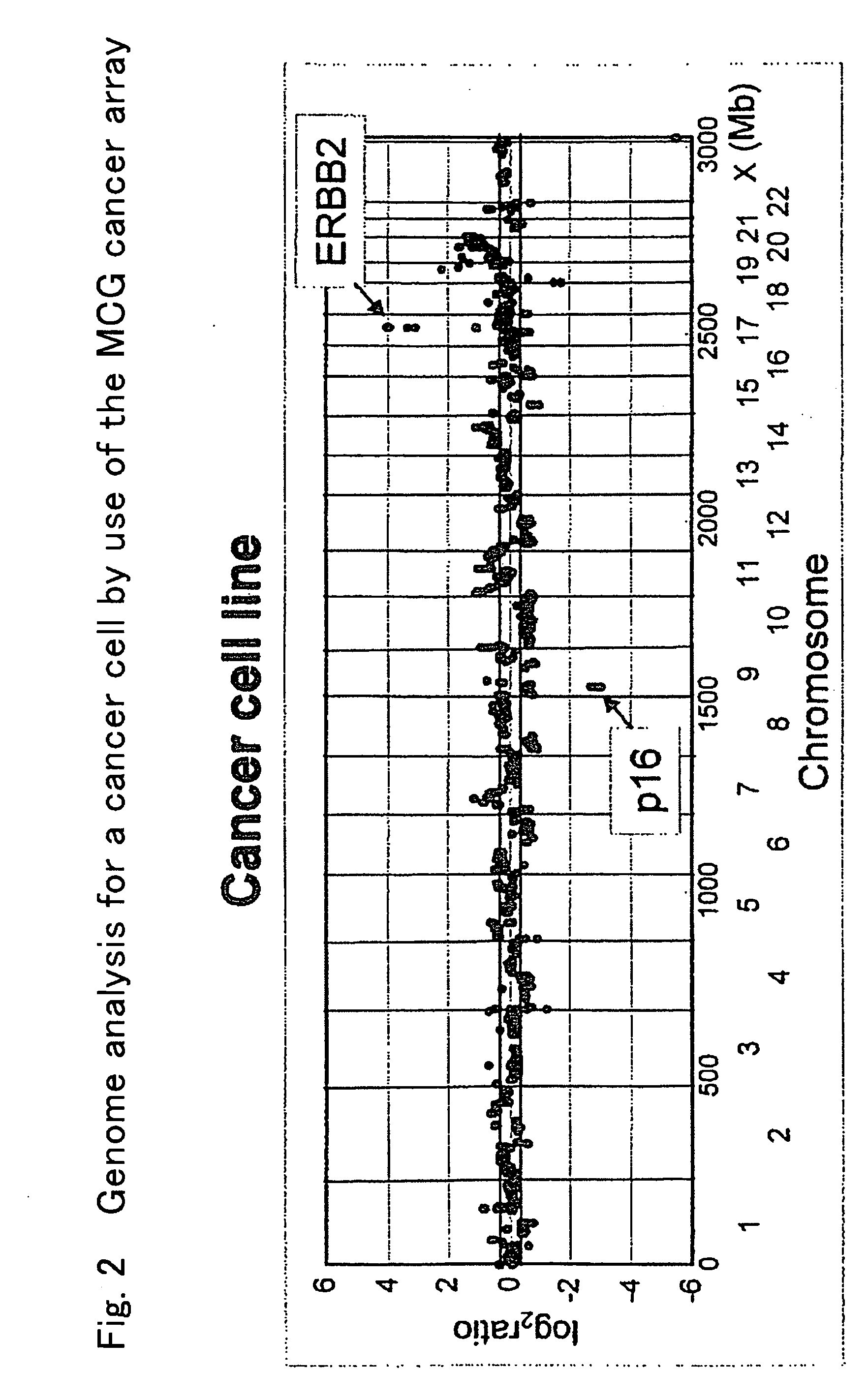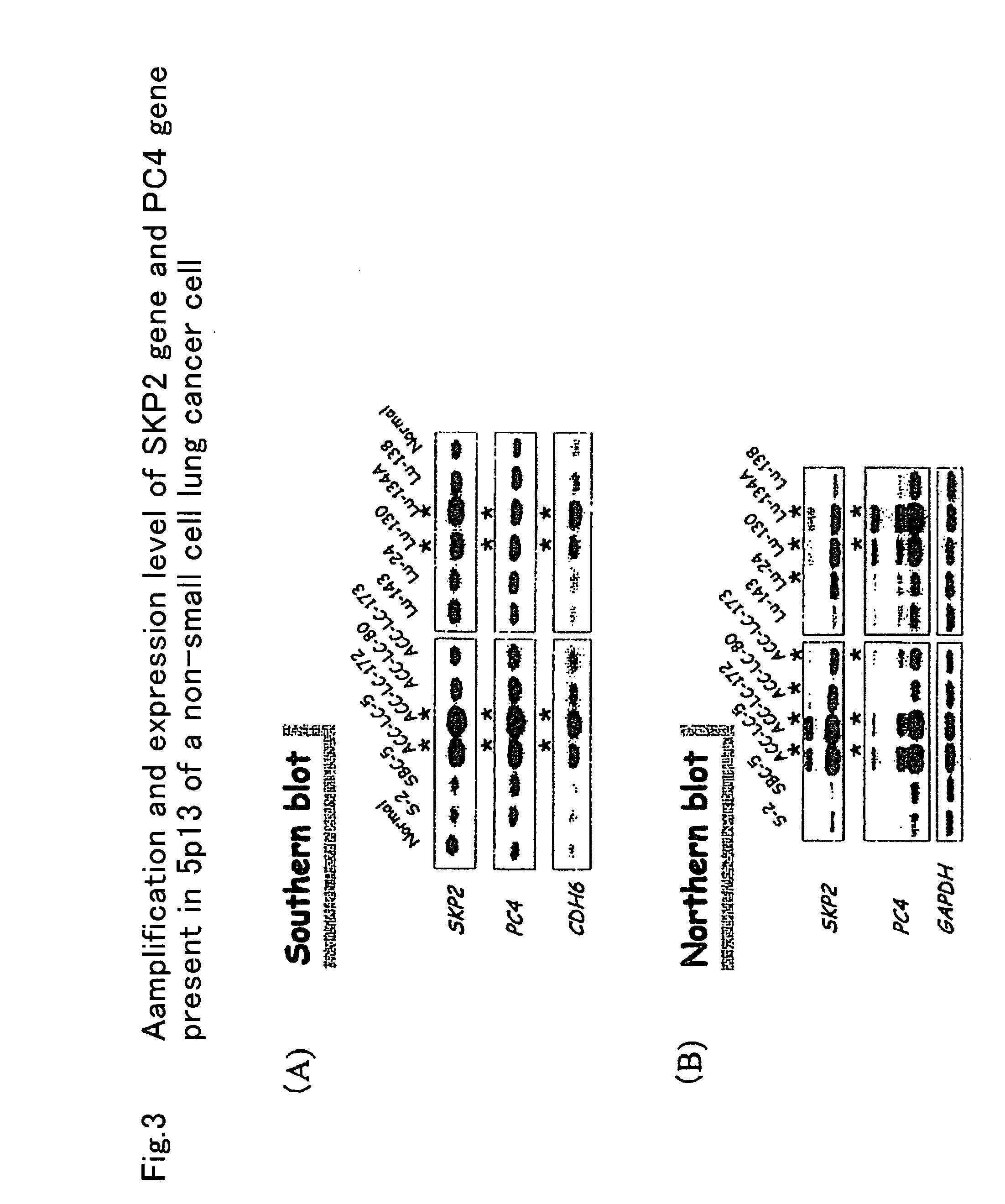Method for detecting cancer and a method for suppressing cancer
a cancer and cancer cell technology, applied in the field of cancer detection and cancer suppression, can solve the problems of unregulated proliferation and initiating canceration, and achieve the effect of suppressing a bile duct cancer cell
- Summary
- Abstract
- Description
- Claims
- Application Information
AI Technical Summary
Benefits of technology
Problems solved by technology
Method used
Image
Examples
example 1
Preparation of “MCG Cancer Array”
[0053] Based on the search for genome database website of the National Cancer for Biotechnology and University of California, Santa Cruz Biotechnology as well as BLAST search of DNA screened, BAC / PAC clones having an extremely important gene for canceration and amplification of a cancer cell or having a sequence tagged site marker were selected.
[0054] BAC and PAC DNA was digested with Dpn1, RsaI, and HaeIII, and thereafter ligated with adaptor DNA. PCR was performed twice using a primer having the sequence of the adaptor. One of the two ends of the primers has the 5′ end aminated. This process is called an inexhaustible process and DNA thus obtained is defined as inexhaustible DNA. The inexhaustible DNA is placed in an ink-jet type spotter (GENESHOT, NGK Insulators, Ltd., Nagoya) and covalently printed, in duplicate, onto an oligo DNA micro array (manufactured by Matsunami Glass, Osaka).
example 2
Collective Analysis of a Cancer-Associated Gene in Bile Duct Cancer By Use of the MCG Cancer Array
[0055] Using the “MCG cancer array,” an amplified and deleted gene was analyzed with respect to bile duct cancer cells. A gene amplified and having a Ratio value of 1.32 or more was checked. As a result, ZNF131, DOC2, DAB2, PC4, SKP2, CDH10, CDH12, TERT, CDK5, BAI1, PSCA, MLZE, RECQL4, BCL1, FGF4, ITGB4, Survivin, SRC, PTPN1, PCTK1, and CTAG were found (Table 2). The amplification of these genes was detected in 50 to 75% of 8 bile duct cancer cell lines tested herein.
TABLE 2Name of gene amplified and having a Ratio valueof 1.32 or more in bile duct cancer cellNumber ofChromosomal regionName of amplified genecell linesPercentage5p12ZNF131562.55p13DOC2, DAB26755p13PC4562.55p13SKP2562.55p14.2CDH106755p14.3CDH126755p15TERT6757q36CDK54508q24BAI14508q24.2PSCA4508q24.21MLZE4508q24.3RECQL445011q13.3BCL1, FGF4562.517q11-qterITGB467517q25Survivin67520q12SRC562.520q12PTPN1450Xp11PCTK1450Xq28CT...
example 3
Inhibition of Proliferation of Small-Cell Lung Cancer Cell By an SKP2 Gene Antisense Oligonucleotide
[0058] In small cell lung cancer cell, a chromosomal 5p13 region is amplified. Of the small cell lung cancer cell lines, ACC-LC-5 cell line, ACC-LC-172 cell line, Lu-130 cell line, and Lu-134 cell line were investigated. As a result, CDH6, PC4, and SKP2 genes present in the 5p13 region were significantly amplified at a chromosome level by the Southern blot method. When the expression of these genes was analyzed by the Northern blot method, it was found that a significant increase was observed compared to a normal cell (FIG. 3). As a result of culturing these cells in the presence of an SKP2 antisense oligonucleotide, the amount of SKP2-mRNA was significantly reduced. In accordance with this, the proliferation of cells was suppressed to a level of 25% compared to a control cell to which a sense oligonucleotide was added. The inhibition with the SKP2 antisense oligonucleotide added to...
PUM
| Property | Measurement | Unit |
|---|---|---|
| diameter | aaaaa | aaaaa |
| length | aaaaa | aaaaa |
| temperature | aaaaa | aaaaa |
Abstract
Description
Claims
Application Information
 Login to View More
Login to View More - R&D
- Intellectual Property
- Life Sciences
- Materials
- Tech Scout
- Unparalleled Data Quality
- Higher Quality Content
- 60% Fewer Hallucinations
Browse by: Latest US Patents, China's latest patents, Technical Efficacy Thesaurus, Application Domain, Technology Topic, Popular Technical Reports.
© 2025 PatSnap. All rights reserved.Legal|Privacy policy|Modern Slavery Act Transparency Statement|Sitemap|About US| Contact US: help@patsnap.com



